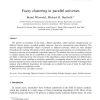Free Online Productivity Tools
i2Speak
i2Symbol
i2OCR
iTex2Img
iWeb2Print
iWeb2Shot
i2Type
iPdf2Split
iPdf2Merge
i2Bopomofo
i2Arabic
i2Style
i2Image
i2PDF
iLatex2Rtf
Sci2ools
IJAR
2007
2007
Fuzzy clustering in parallel universes
We present an extension of the fuzzy c-Means algorithm, which operates simultaneously on different feature spaces—so-called parallel universes—and also incorporates noise detection. The method assigns membership values of patterns to different universes, which are then adopted throughout the training. This leads to better clustering results since patterns not contributing to clustering in a universe are (completely or partially) ignored. The method also uses an auxiliary universe to capture patterns that do not contribute to any of the clusters in the real universes and therefore are likely to represent noise. The outcome of the algorithm is clusters distributed over different parallel universes, each modeling a particular, potentially overlapping subset of the data and a set of patterns detected as noise. One potential target application of the proposed method is biological data analysis where different descriptors for molecules are available but none of them by itself shows ...
| Added | 14 Dec 2010 |
| Updated | 14 Dec 2010 |
| Type | Journal |
| Year | 2007 |
| Where | IJAR |
| Authors | Bernd Wiswedel, Michael R. Berthold |
Comments (0)

